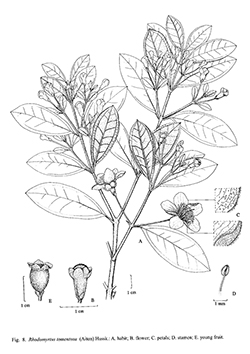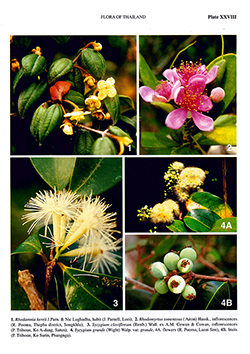e-Flora of Thailand
Volume 7 > Part 4 > Year 2002 > Page 809 > Myrtaceae > Rhodomyrtus
Rhodomyrtus tomentosa (Aiton) Hassk.wfo-0000296387
Flora 25: 35. 1842; Miq., Sum. seine Pflanzenwelt: 1200. 1862; Miq., Fl. Ind. Bat 1: 477. 1855; Koord. & Valeton, Bijdr. Boomsoort. Java 6: 41. 1900; Backer, Schoolfl. Java: 499. 1911; Koord. in Exkurs.-Fl. Java 2: 674. 1912; Gagnep. in Lec., Fl. Gén. I.-C. 2: 794. 1920; Backer & Bakh.f., Fl. Java 1: 335. 1963; Kochummen in Ng, Tree Fl. Mal. 3: 251. 1978; Ridl., Fl. Malay Penins. 1: 717. 1922; Craib in Fl. Siam. Enum. 1: 628. 1931, Scott, Kew Bull. 33: 313. 1978; P.H.Hô, Câyco Viêtnam 2: 43. 1992; Turner, Gard. Bull. Singapore 47: 371. 1995.— Myrtus tomentosa Aiton, Hort. Kew, ed. 1, 2: 159. 1789; Corner, Ways. Trees 1: 508. 1940. Fig. 8; Plate XXVIII: 2.
Accepted Name : This is currently accepted.
Description : Shrub or small tree less than 4 m. Outer bark light brown soon flaking or peeling to reveal orangish-red underbark. Twigs dark brown tomentose when mature. Leaves ovate to elliptic; 2–10 by 1.5–4 cm; tripliveined with an intramarginal vein; margin sub-revolute; apex obtuse, acute or apiculate; glandular (bright light needed); upper surface dark brown on drying, more or less glabrous, veins often slightly impressed, obscure, sometimes white pubescent at the base; lower surface ocherous on drying, tomentose, sub-hispid with scattered dark brown hairs (especially on the veins), primary veins raised. Petioles ca 5 mm, angled, tomentose. Flowers axillary or terminal, solitary or in dichasia. Peduncles 1–2 cm densely tomentose and sub-hispid. Pedicels up to 1.5 cm, tomentose. Pseudostipe present, 4–8 mm. Calyx infundibuliform, ca 10 mm; lobes obtuse ca 6 mm, inner 2 lobes longer than outer 3, densely tomentose. Petals pink, white-tomentose on outside, 1.5–2 cm long. Stamens numerous, filaments 10 mm long, connective with a minute apical gland. Style ca 1.5 cm. Hypanthium shallowly cup-shaped or flat, hoary. Fruit ca 9 by 10 mm, green, red or purple, densely tomentose. Seeds 2 mm by 3 mm, light brown, tuberculate, reniform.
Thailand : EASTERN: Nakhon Ratchasima; SOUTH-WESTERN: Prachuap Khiri Khan; SOUTH-EASTERN: Chon Buri, Rayong, Chanthaburi, Trat; PENINSULAR: Chumphon, Phangnga, Phuket, Krabi, Songkhla, Narathiwat.
Distribution : India, Sri Lanka, Burma, Laos, Cambodia, Vietnam, China (type cultivated at K), Malaya, Sumatra, Java, Lesser Sunda Islands, Borneo, Moluccas, Celebes, the Philippines.
Ecology : Common in coastal (sometimes swampy) forests or scrub also in second ary forests and by roadsides, usually below 100 m alt.
Vernacular : Ngai (ง้าย)(Suai); pui (ปุ้ย)(Khmer-Eastern); phruat yai (พรวดใหญ่)(Chon Buri); phruat phi (พรวดผี)(Rayong); suat (ซวด)(Chanthaburi); phruat (พรวด)(Trat); ka thu (กาทุ)(Chumphon); tho (โทะ)(Peninsular); mu-ting (มูติง)(Malay-Peninsular).
CommonName : Rose myrtle, Downy myrtle, Hill gooseberry.
Uses: The fruit is edible. The leaves, roots and fruits appear to relieve digestive complaints of various types and a decoction can be used externally to wash and clean wounds.


